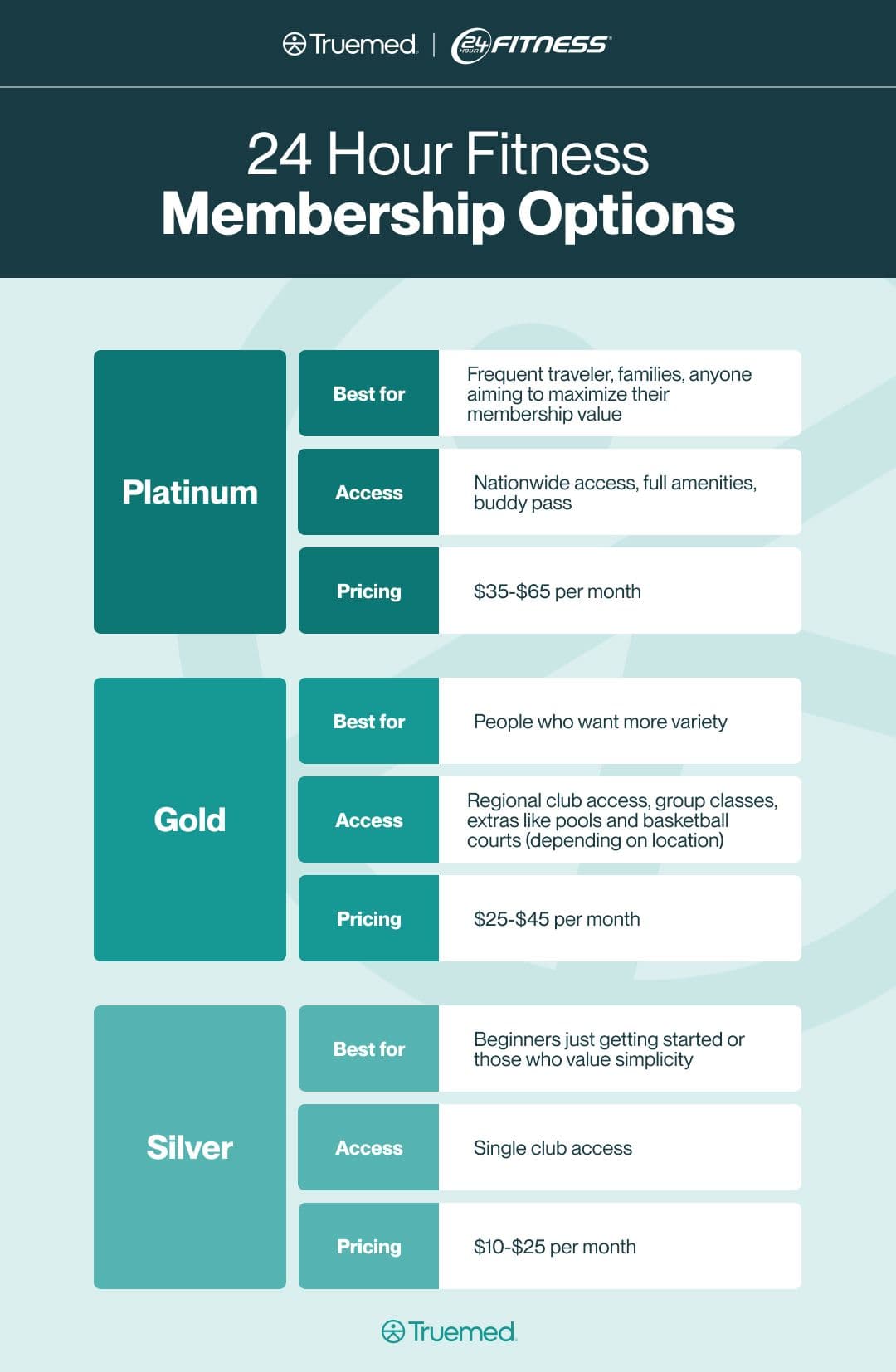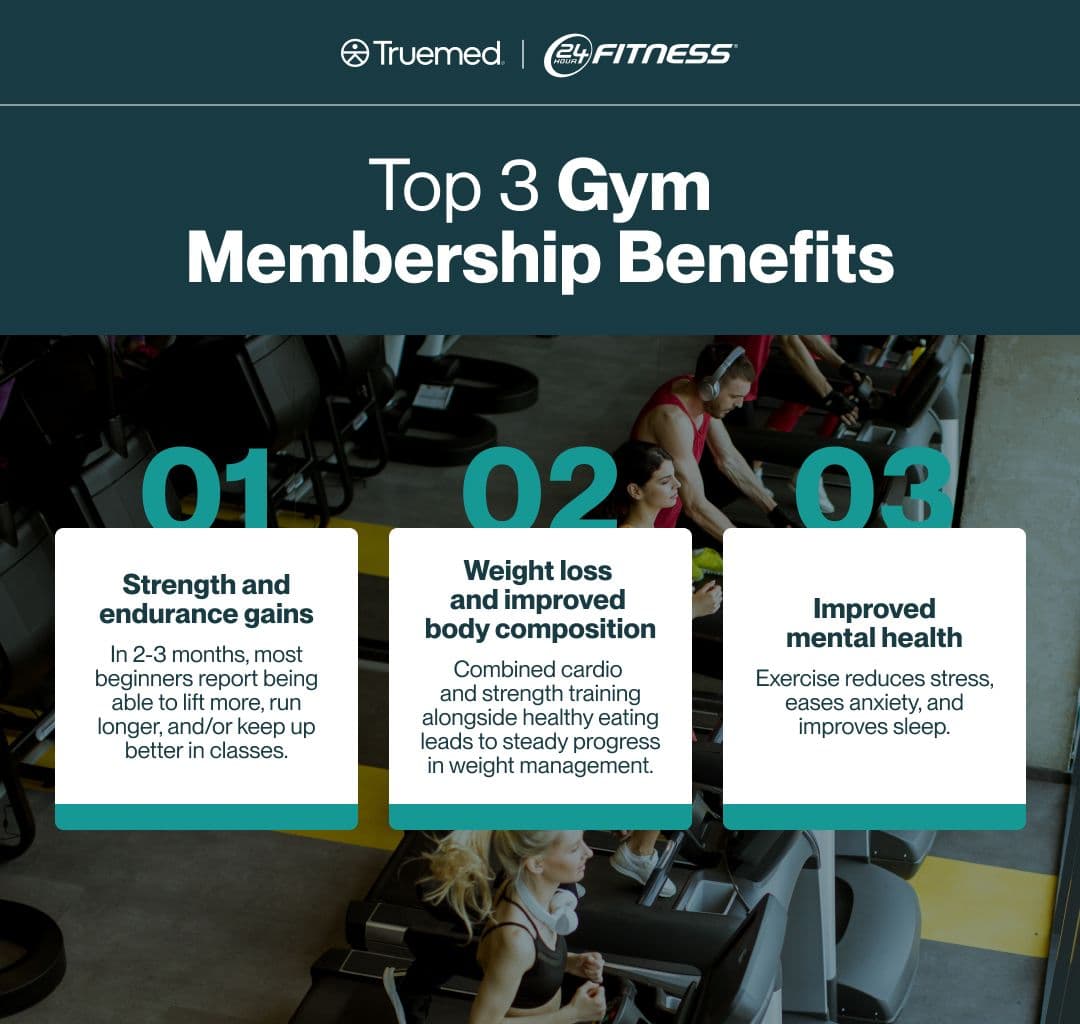24 Hour Fitness Gym: Membership, Pricing, and Results
Author:Kathleen Ferraro
Reviewed By:Michaela Robbins, DNP&Bo Hickey, CSCS
Published:
September 16, 2025

What Is 24 Hour Fitness?
Are All Locations Open 24 Hours?
Membership Options and Pricing
What’s Included in a 24 Hour Fitness Membership?
Facilities & Atmosphere
Who Is 24 Hour Fitness Best For?
Considerations Before Joining
How To Save on 24 Hour Fitness Gym Memberships with a HSA/FSA
How It Compares to Other 24/7 Gym Chains
Results: What Can You Expect?
Key Takeaways
FAQ
24 Hour Fitness Gym: Membership, Pricing, and Results
Thinking about joining a 24 Hour Fitness gym? Memberships range from $10 to $65 per month depending on the tier and location, with perks like group classes, pools, and even buddy passes for Platinum members. Not every club is open 24/7, but the chain is known for its spacious facilities and wide variety of workouts. And if your doctor recommends exercise for your health, Truemed may help you pay with pre-tax HSA/FSA dollars.
24 Hour Fitness is one of the most recognizable gym chains in the U.S., with massive clubs that cater to a wide range of fitness needs. Known for their size and variety, many locations offer extended or even 24/7 hours, giving busy members more flexibility than smaller gyms and studios can provide. Inside, you’ll find rows of cardio machines, strength equipment, pools, basketball courts, and group classes ranging from yoga to HIIT.
But is it worth the membership cost? Prices vary depending on the tier and location, and the experience can differ from one club to the next. In this guide, we’ll break down what you get with a 24 Hour Fitness membership—including hours, pricing, equipment, classes, and extras—and help you decide if it’s the right fit for your goals.
What Is 24 Hour Fitness?
24 Hour Fitness launched in California in 1983 and has grown into one of the largest gym chains in the country, with more than 240 locations. Its clubs are known for their size (30,000 to 40,000 square feet on average), wide-open strength and cardio floors, and amenities that appeal to both casual exercisers and serious athletes, says Jennifer Garrett, the senior director of member support services at 24 Hour Fitness.
The company’s mission is simple: Make fitness accessible no matter where you’re starting from. Whether you’re a first-timer learning how to use a treadmill or you’re deep into Olympic lifts and HIIT circuits, you’ll find equipment, classes, and coaching that meet you where you are.
“24 Hour Fitness is built around accessibility, community, and service to our members,” says Garrett. “Our clubs balance state-of-the-art equipment with simple, approachable programs, whether that’s individual personal training, self-directed cardio and strength building, boutique-style group exercise classes, or the latest in recovery and rebuilding, all so we can meet members wherever they are on their fitness journey.”
Are All Locations Open 24 Hours?
The name 24 Hour Fitness suggests that every club is open around the clock, but that’s not always the case. While some locations do operate 24/7, others have more limited schedules, often closing overnight or shortening hours on weekends and holidays. Operating hours can vary depending on the club's size, local demand, staffing, and city regulations.
This can be a make-or-break factor for members who want the freedom to work out in the middle of the night or before dawn. If late-night or early-morning access is a priority, be sure to double-check the exact hours at your nearest location. You can filter by “Open 24 hours” when searching for clubs on the 24 Hour Fitness website to ensure you’re joining one that matches your lifestyle.
In addition to individual club differences, 24 Hour Fitness categorizes its gyms into tiers, with each step up offering more amenities. Here’s the breakdown:
- Active Clubs: These gyms focus on the basics, like cardio and strength training equipment, along with some group classes. They’re usually the most affordable option, but hours can be more limited.
- Sport Clubs: These add amenities like lap pools, basketball courts, and personal training services. Memberships cost a bit more, but you also get longer hours and more variety.
- Super-Sport Clubs: These larger gyms include elite resources, including premium recovery spaces and state-of-the-art private training areas. Prices climb at this tier, but so do the amenities, and you’re more likely to find extended or even 24-hour access.
- Ultra-Sport Clubs: These top-tier facilities feature aquatic centers, spas, and racquetball courts. They come with the highest price tag but often the best chance of true round-the-clock access.
Membership Options and Pricing
Memberships at 24 Hour Fitness are designed to fit different lifestyles, budgets, and fitness goals. There are three main membership tiers:
- Silver: This is the entry-level option, best for beginners or anyone who plans to stick to a single club. For people just getting started or those who value simplicity, Silver provides the basics without extras.
- Gold: A step up from Silver, Gold memberships add regional club access and more amenities. This typically means access to group classes, plus extras like pools and basketball courts (depending on the location). It’s a strong middle ground for people who want more variety without paying for nationwide access.
- Platinum: The top-level option, Platinum provides nationwide access to all clubs, full amenities, and the coveted buddy pass that you can use whenever you work out. This tier is ideal for frequent travelers, families, or those who want to maximize the value of their membership.
Sp, how much is a gym membership at 24 Hour Fitness? Pricing varies by location, but the typical monthly price ranges (before taxes and fees) for each tier are:
- Silver: $10 to $25 per month
- Gold: $25 to $45 per month
- Platinum: $35 to $65 per month
In addition to the monthly membership fee, members should expect other potential costs such as initiation fees (which vary by location and are sometimes waived during promotions) and annual charges, typically $49 to $79, billed once per year.
There are also discounts available. Military personnel, first responders, seniors, and those enrolled through corporate health partnerships may qualify for reduced membership rates.
Garrett also notes that members can use HSA/FSA (health savings account and flexible savings account) dollars to pay for a membership if their doctor prescribes exercise as part of a health plan, making the investment even more affordable. Truemed helps streamline this process by providing a letter of medical necessity from a licensed clinician—the documentation most HSA/FSA providers require to approve expenses like a gym membership.

What’s Included in a 24 Hour Fitness Membership?
At most clubs, a 24 Hour Fitness membership goes far beyond treadmills and dumbbells. Depending on your location and membership tier, here’s what you can expect:
- Equipment: Every club has rows of cardio machines (treadmills, ellipticals, stair climbers, bikes), racks of free weights, lifting platforms, and strength machines. Many also include functional training rigs, kettlebells, and turf training areas.
- Classes: From Zumba and spin to high-intensity bootcamps, group fitness classes are a major draw. Larger Super-Sport and Ultra-Sport clubs may run dozens of classes per week across multiple studios.
- Amenities: Pools, hot tubs, saunas, steam rooms, recovery spaces, basketball courts, and racquetball courts are available at mid- to upper-tier locations.
- Extras (add-ons): For an additional fee, members can work with a personal trainer, sign up for small group coaching, book nutrition consultations, or access Premium24 advanced strength training programs. Towel service and locker rentals are optional upgrades at some gyms.
- Digital tools: The free 24GO app allows you to book classes, log workouts, follow on-demand training plans, and even stream workouts from home. This helps members stay consistent whether they’re at the gym or traveling.
Ultimately, the appeal of 24 Hour Fitness is variety under one roof: A single visit could include swimming laps, hitting the squat rack, and cooling down with a yoga class. For members who get bored easily or want the flexibility to change up their training style, that mix of fitness equipment, classes, and amenities is what keeps them coming back.
Facilities & Atmosphere
Most 24 Hour Fitness gyms are designed to feel approachable rather than intimidating, with layouts that balance community and independence. The average club has ample space for multiple workout zones like strength floors, cardio decks, turf training areas, and group fitness studios.
That size is part of the brand’s appeal: Members can usually find a corner for their workout even when the gym is busy during peak hours (typically 7 to 9 a.m. and 5 to 7 p.m.). Staff are available throughout the day, and general managers are in the process of becoming certified trainers, meaning there’s usually someone knowledgeable on-site if you need help, says Garrett.
Member experiences can vary from club to club. Reviews often highlight differences in upkeep between gyms, with suburban locations typically scoring higher for space, equipment condition, and overall atmosphere. In high-traffic urban gyms, peak hours can bring crowding, wait times for equipment, and wear-and-tear that shows more quickly.
The vibe overall is “all-around fitness” rather than hyper-specialized. You’ll see parents swimming laps, students lifting free weights, and professionals dropping into a HIIT class after work. While it’s not the kind of hardcore bodybuilding environment you’d find in a powerlifting gym, there’s still plenty of equipment to support serious lifters alongside amenities that make the space accessible for beginners.
Who Is 24 Hour Fitness Best For?
The chain serves a wide range of members, but 24 Hour Fitness is a good gym for certain groups in particular, including:
- Busy adults: With flexible hours (including some 24/7 clubs) and multiple locations, 24 Hour Fitness works well for people who need to squeeze workouts into packed schedules.
- Families and couples: Platinum memberships come with buddy passes, meaning you can bring a partner, spouse, or friend without paying for two separate accounts. Add in pools, basketball courts, and kids’ programs at many clubs, and it becomes a family-friendly fitness solution.
- Beginners and intermediates: The wide range of approachable classes and equipment makes 24 Hour Fitness a solid choice if you’re just getting started or still building confidence in the gym. Staff are present throughout the day, and the environment is designed to feel welcoming rather than intimidating. Classes can also provide structure for those who aren’t sure where to start.
- People who want variety: For members who like to switch it up, the ability to cross-train in one place is a huge benefit. A single membership can give you access to cardio, weights, group classes, pools, and even basketball courts.
Considerations Before Joining
Like any large gym chain, 24 Hour Fitness has strengths and trade-offs that depend on your priorities. Here are a few things to weigh as you decide if it’s the right fit:
- Not every location is open 24/7: Some clubs close overnight or reduce weekend schedules, so it’s important to check your local gym’s exact hours.
- Guest experience can vary: With clubs spread across the country, the member experience isn’t uniform. Suburban gyms often have more space and newer equipment, while high-traffic urban locations may feel more crowded and show faster wear and tear.
- Membership costs are higher than those of budget gyms: Compared to no-frills chains like Planet Fitness, some 24 Hour Fitness membership tiers fall within a mid-range price point. For some, the added classes, pools, and amenities justify the extra cost; for others, the basics may be all that’s needed.
- Policies may feel stricter than boutique gyms: Large chains often have more structured billing and cancellation policies. That means you’ll want to read the fine print on contract terms before you commit, especially if you prefer flexibility.
These aren’t deal-breakers for most members, but they’re worth considering. The key is knowing what matters most for your routine, whether that’s unlimited hours, premium amenities, or simply a place close to home where you’ll actually show up.
How To Save on 24 Hour Fitness Gym Memberships with a HSA/FSA
If your doctor recommends exercise to manage a health condition—such as obesity, type 2 diabetes, or hypertension—your gym membership may qualify as a medical expense.
That means you could use pre-tax HSA or FSA dollars to cover part or all of your membership fees. Since HSA/FSA contributions are made before taxes, applying them toward your membership can save you ~30%* on the overall cost.
Traditionally, using HSA/FSA dollars for a gym membership is confusing. Most providers require a letter of medical necessity from a licensed clinician to prove that your fitness expenses are part of a treatment plan. Truemed takes the guesswork out of this process by:
- Reviewing your health needs for eligibility: An online intake helps determine if your fitness goals align with a medical need like weight loss, metabolic health, or stress reduction.
- Providing the required documentation: Truemed allows you to take a health survey, which is then reviewed by a licensed clinician. Then, if approved, the clinician can issue a letter of medical necessity.
- Connecting you to approved gyms, including 24 Hour Fitness: With the letter of medical necessity in place, you’re eligible to use HSA/FSA funds.
How It Compares to Other 24/7 Gym Chains
If you’re considering 24 Hour Fitness, it's helpful to compare it with other major chains that offer extended or around-the-clock hours, including:
- Planet Fitness: This chain can be more affordable ($15 to $30 per month), but it offers fewer equipment options and amenities compared to 24 Hour Fitness.
- Anytime Fitness: Most locations cost $40 to $70 per month and guarantee 24/7 access, but may not offer the same range of amenities.
- Snap Fitness: Costs vary by club, but single memberships typically run $35 to $60 per month and guarantee 24/7 access. However, amenities may be limited.
24 Hour Fitness stands out for its class variety, pools, and larger facilities, all at a low- to mid-range price point of about $10 to $65 per month, depending on your membership tier. Compared to these competitors that lean heavily on convenience, it’s more of a “full lifestyle gym” designed to offer everything under one roof.
Results: What Can You Expect?
At the end of the day, what you get out of a 24 Hour Fitness membership depends largely on what you put in. Consistency is the biggest driver of results, no matter if your goal is weight loss, building muscle, or simply moving more.
Research consistently shows that structured exercise improves cardiovascular health, reduces stress, boosts mood, supports long-term weight management, and aids in the management or prevention of many chronic health conditions. In other words, showing up regularly matters more than having the “perfect” workout.
Among members, common results include:
- Noticeable strength and endurance gains within two to three months: Many beginners report being able to lift heavier weights, run longer distances, or keep up better in classes after a consistent few months.
- Weight loss and improved body composition: When gym sessions are paired with dietary changes, members often see steady progress in weight management, especially when they take advantage of both cardio and strength training.
- Improved mental health: Regular exercise is strongly linked to reduced stress, lower anxiety, and better sleep; benefits that members often mention as much as the physical ones.
It’s also worth noting that 24 Hour Fitness provides an environment where members can scale their routines over time. Having a variety of equipment, classes, and spaces in one facility makes it easier to stay engaged and avoid plateaus.
“We know that everyone who walks in our door is taking a big step towards their better self,” says Garrett. “We’ve built a friendly environment that keeps our members progressing towards their goals.”
*On average, 30% of gross income is paid to state and federal tax. Individual tax rates vary. To see your estimated savings, check out the TrueSavings Estimator.

24 Hour Fitness membership prices can vary: You could pay anywhere from $10 to $65 per month, depending on your tier, with Silver, Gold, and Platinum options offering different levels of access and perks.
Not every club is open 24/7: It’s important to check your local location’s hours and tier (Active, Sport, Super-Sport, or Ultra-Sport) before committing.
Memberships can include far more than treadmills and weights: Many clubs offer group classes, pools, saunas, basketball courts, recovery lounges, and access to the 24GO app.
One membership covers multiple fitness needs: That's why 24 Hour Fitness is best suited for busy adults, families, beginners, and anyone who values variety.
You could pay with HSA or FSA funds: With Truemed, you may be able to use HSA or FSA dollars to pay for your membership if your doctor prescribes exercise for a health condition, potentially saving ~30%* on your costs.
Editorial Standards
At Truemed, we believe better health starts with trusted information. Our mission is to empower readers with accurate and accessible content grounded in peer-reviewed research, expert insight, and clinical guidance to make smarter health decisions. Every article is written or reviewed by qualified professionals and updated regularly to reflect the latest evidence. For more details on our rigorous editorial process, see here.


